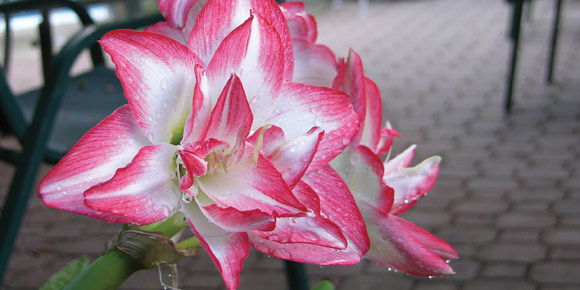Amaryllis is one of the most popular holiday season plants. The big, voluptuous blooms in red, white, pink or candy-stripes have returned to the glory of their Victorian conservatory days. The flower has been reclassified, though. It’s now known officially as Hippeastrum. Just to confuse you, the plant with the Latin name of Amaryllis is commonly known as belladonna lily, but for this discussion, we’ll stick to the good old fashioned moniker.
Amaryllis is native to Mexico, but was hybridized and popularized by the Dutch who were and are the world masters at hybridizing bulbs. They worked their magic on amaryllis before it found its way to America in the 18th century.
Many bulbs, like tulips and paper whites, need a cold dormant period before they can bloom, but amaryllis doesn’t, although you can force an amaryllis into dormancy by keeping it at about 5° Celsius; then you can bring it out of dormancy to bloom when it suits you. If you never chill it, the foliage will stay green and the plant will eventually bloom again.
If you prefer to take control over when your amaryllis blooms, here’s what you do. Keep the plant outside in partial shade all summer so the leaves can soak up all the energy possible for the plant to produce a nice show at bloom time. It helps to sink the pot into the ground to guard against dehydration. Get it back inside before it’s in any danger of frost, then force it into dormancy by keeping it in a dark, cool location with no water for about eight weeks. Depending on the variety, it will take from two weeks to a couple of months to bloom once you bring it out and water it again.
If your amaryllis doesn’t come with a pot, the rule is to choose one that is only an inch or two bigger than the bulb. Like many of us, amaryllis bulbs increase in girth as they get older, adding about half an inch each year. You’ll need to re-pot every couple of years to accommodate the growth.
Nothing bad will happen if you use a bigger pot, but you will get bulb offshoots from the mother plant that may delay blooming. I planted one in a larger pot a few years ago and now have a whole bouquet of blossoms.
When planting, be sure to leave the top third of the bulb poking up above the soil.
You could conceivably collect seeds from your amaryllis and grow new plants, but the exercise is not for the impatient. First, allowing the plant’s energy to go into producing a seed will mean that there is less energy to go into developing the bulb, which means a smaller bloom next year from your parent plant. Second, the baby plant probably won’t look like the parent. And third, it will take up to five years to produce a flower.
If your plant gets good leaves but doesn’t bloom, give it a second chance before tossing it on the compost heap. Fertilize through the growing period with 20-20-20 and make sure the plant gets optimal light without getting strong, direct sunlight that could scorch the leaves. Then follow the steps above and chances are you’ll be rewarded.
Amaryllis bulbs are particularly susceptible to rot if they’re left in clammy quarters. Make sure the pot you use has drainage holes in the bottom. When you first plant the bulb, give the soil a good soaking, letting the excess water drain out into the sink; don’t leave the drainage tray full of water. Take particular care not to water the nose of the bulb. After that first watering, don’t give it anything more until growth shows, and then only when the soil is dry. (If the soil dries out before you see growth then water sparingly.)
Once the plant has two nice big leaves on it, go ahead and water about once per week.
Dorothy Dobbie is the publisher of Manitoba Gardner magazine, which is celebrating its 20th anniversary of continuous publication in 2018. If you would like to subscribe, call 204-940-2700 and Shelley will take you order. Or you can go to localgardner.net and subscribe on line.



